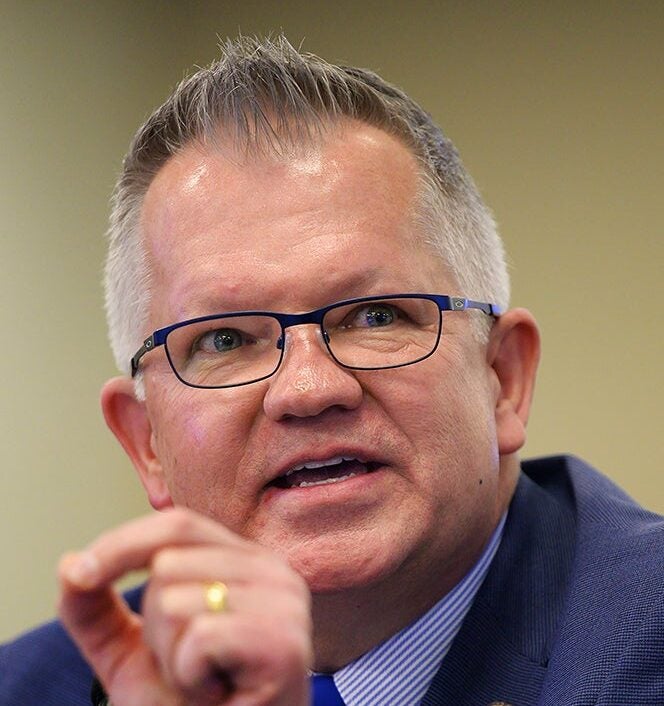‘Predictable:’ The Horizons Act is dead, how will child care be impacted?
Published 5:24 pm Friday, March 22, 2024

- FRANKFORT, Feb. 20 – Sen. Danny Carroll, R-Benton , presents Senate Bill 203, an act related to early childhood education, during the Tuesday meeting of the Senate Committee on Families and Children. (LRC Public Information)
The Horizons Act is dead.
As pandemic-era support expires and a federal funding cliff looms, the $300 million bill would have established various programs and funds to sustain and develop current early childhood education centers.
The bill included a new associate degree program at the Kentucky Community and Technical College System for interdisciplinary early childhood education entrepreneurship to encourage the creation of new centers in early childhood education deserts.
It would have allocated $68 million in state funds to centers based on the number of children enrolled, similar to how SEEK education funding works. Several programs supporting child care providers were included.
But sponsor Sen. Danny Carroll, R-Benton, said the Horizons Act isn’t making it to the Senate floor.
He feels comfortable that some aspects of the bill will end up in the final budget, but fears that the most important ones—funding to help keep centers open—will be left out.
Carroll said that the state devotes about half of its budget to education, amounting to nearly $7 billion each biennium.
“These centers are set up just like schools; there’s curriculums, there’s testing, all the components are there,” he said. “Our early childhood educators are getting more training now, we have scholarships in place, all of those things, but philosophically, we just look at our youngest kids as less important when it comes to education.”
The budget
The Senate’s budget included a few components of the Horizons Act.
It covers $1.3 million worth of required background checks each year, as well as $2 million each year to support an Innovations in Early Childhood Education Delivery Fund.
That fund provides up to $100,000 grants for people or businesses to start early childhood education centers with non-traditional delivery models.
Kentucky’s Child Care Assistance Program helps families whose income is at or below 85% of the state median income with child care costs. The current budgets raise this threshold to 80%, cutting some families out.
However, the Senate includes funds for families’ six-month transition out of CCAP.
What happens if child care is not funded?
Over the past decade, Kentucky has lost half of its child care providers. It’s expected to lose 20 to 30% more if the issue is not addressed.
When federal aid became available, Kentucky centers raised their pay to $13 an hour to maximize the federal funds they could receive through the American Rescue Plan Act, Carroll said.
Now that ARPA aid is gone, centers have three choices, he said.
First, they could raise their rates to make up for lost funding, but that may price out parents along the way. This would lead to more family members leaving the workforce to stay home and take care of their kids.
Second, centers could cut their employees’ pay. However, childcare worker pay is already comparable to what a fast food or retail worker makes, and if it gets any lower, Carroll said centers will see an exodus.
“We saw this happen before when everybody else’s pay rates were going up during COVID before the centers were able to pay more,” he said. “It’s predictable, what’s going to happen.”
Third, centers could close their doors. Nearly two-thirds of Kentucky counties are already classified as child care deserts, with more than three children per available child care slot.
Kentucky Center for Economic Policy surveyed 1,357 Kentucky parents with children in child care this March, asking about their concerns.
60% of respondents who were not CCAP participants said they spent between $100 to $300 per week in child care, while 29% paid over $300.
Kentuckians have organized their lives around the cost of childcare. The survey found that 12% of respondents had left the workforce to take care of their children, while 39% changed their work hours.
This disproportionately hurts mothers. According to the Federal Reserve Bank of St. Louis, about 65% of mothers of young children are in the workforce, while 95% of fathers remain in the workforce.
“A constant conversation we hear in Frankfort right now is that we need to get more people working and this seems like a situation where you can’t have your cake and eat it too,” said Dustin Pugel, KyPolicy policy director.
In a press call last week, parents shared their concerns if child care was not funded.
Valerie Frost has three kids under 6 in Clark County. She’s been using CCAP for the past few years, which has allowed her to advance from a part-time to a full-time salaried employee.
However, a very small increase in pay would push her over the edge of the cliff and remove her from CCAP eligibility. She said she’d have to decide between turning down a raise or not being able to afford child care.
Courtney Rhoades Mullins is expecting twins in May. However, neither Letcher and Pike County would have available slots for her children for one to three years.
Mullins said the loss of income from staying home would be devastating for her and her public school teacher husband. It’s not a sustainable option, she said. Particularly in flood-hit Eastern Kentucky, a solid workforce is important, Mullins said.
“You talk a lot about the need for economic development, but until there’s a robust system of childcare, we’re not going to see any change in our communities,” she said.
Carroll thinks that failing to invest in early education like K-12 education will be a huge mistake.
“This is a battle that has just begun,” he said. “We can’t just be satisfied with keeping doors open. I mean, we’ve got to look at this as part of a bigger picture in education.”





